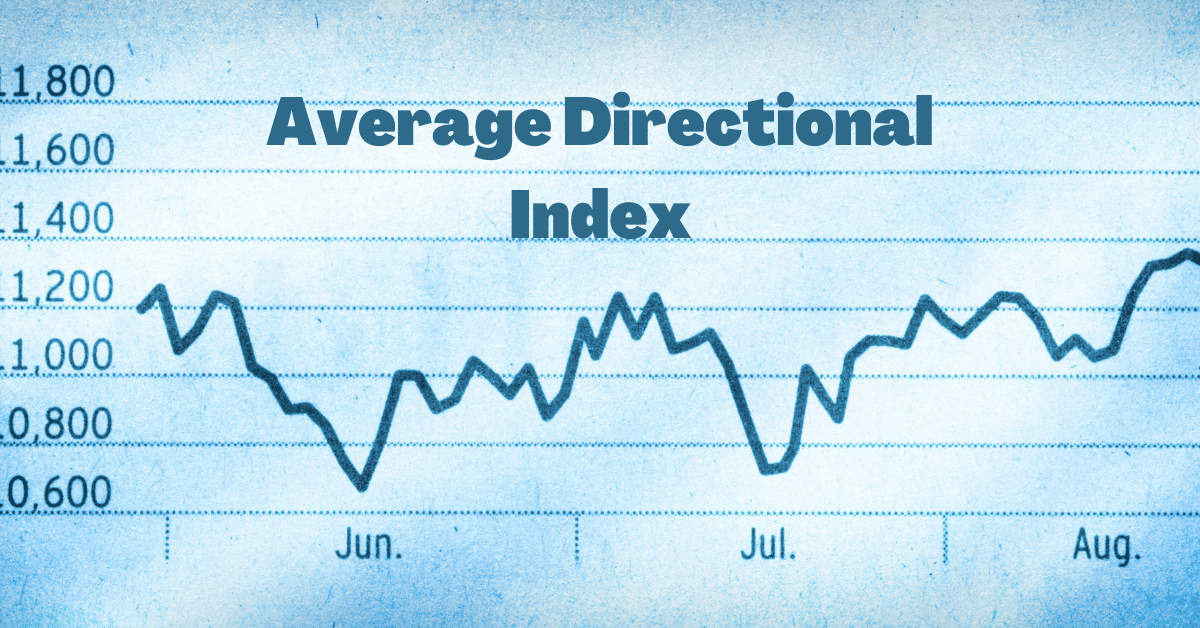The Average Directional Index (ADX) is a technical analysis indicator used to measure the strength of a trend in a financial asset, such as a stock or currency. J. Welles Wilder developed it in the 1970s. It is typically calculated using a moving average of the price range over a specified period of time, usually 14 periods. The value ranges from 0 to 100, with higher values indicating a stronger trend. A value of 0 indicates no trend, while 100 indicates an extremely strong trend.
Traders and investors use the ADX to identify a trend’s strength and determine when to enter or exit a position. If the value is high, it may indicate that the trend is likely to continue, while a low value may indicate that the trend is weak and likely to reverse. It is often used with other technical indicators. Like the Moving Average Convergence Divergence (MACD) or the Relative Strength Index (RSI), to generate, buy or sell signals. For example, if the ADX value is rising while the price is also rising, this may indicate a strong uptrend and a buy signal.
Overall, it is a valuable tool for traders and investors to determine a trend’s strength and identify potential buying or selling opportunities. By analyzing the trend strength and ADX signals, traders can make more informed decisions about when to enter or exit a position.
How is this used in technical analysis to determine trend strength and direction?

The ADX (Average Directional Index) is a technical indicator used in technical analysis to determine a trend’s strength and the market’s direction. Here’s how it is used:
- Identifying Trend Strength: It measures the strength of a trend on a scale from 0 to 100. A higher value indicates a stronger trend, while a lower value indicates a weaker trend. Typically, a value above 25 is considered a strong trend, while a value below 20 is considered weak.
- Determining Trend Direction: It also provides information on the direction of the trend. The ADX line itself does not provide information on trend direction but rather the direction of the two other lines from which the ADX is derived. The positive directional indicator (+DI) line and negative directional indicator (-DI) line are used to identify the direction of the trend. When the +DI is above the -DI, this indicates an uptrend, while a -DI above the +DI indicates a downtrend.
- Combining it with other indicators: Traders and analysts can combine the ADX with other technical indicators to generate trading signals. For example, if it is above 25 and rising, this may indicate a strong uptrend. Suppose it is accompanied by a bullish crossover of the Moving Average Convergence Divergence (MACD) or a rise in the Relative Strength Index (RSI). In that case, this may generate a buy signal.
What are the key elements of the ADX calculation, and how are they interpreted?
The calculation of the Average Directional Index involves several key elements that help determine a trend’s strength and direction.
- Directional Movement: The period’s directional movement (DM) is the first step in calculating it. The DM is the difference between the high and low prices of the current period. Suppose the current period’s high is greater than the previous period’s high, and the current period’s low is higher than the previous period’s low. In that case, the positive directional movement (+DM) equals the current period’s high minus the previous period’s high. If the low of the current period is lower than the previous period’s low, and the high of the current period is lower than the previous period’s high, the negative directional movement (-DM) is equal to the previous period’s low minus the current period’s low.
- True Range: The next step is calculating the period’s true range (TR). The true range is the greatest of the following three values: the high minus the low, the absolute value of the high minus the previous period’s close, or the absolute value of the low minus the previous period’s close.
- Directional Index (DX): The directional index (DX) is determined by dividing the absolute value of the difference of the +DM and -DM by the sum of the +DM and -DM and multiplying the result by 100. The DX indicates the strength of the trend and its direction. A DX value above 25 is considered to be indicative of a strong trend.
- ADX Calculation: This is calculated by taking a moving average of the DX values over a specified period of time, typically 14 periods. The value ranges from 0 to 100, with higher values indicating a stronger trend. A value of 0 indicates no trend, while 100 indicates an extremely strong trend.

The key elements of the calculation include directional movement, true range, directional index, and ADX calculation. By interpreting the ADX value and the direction of the +DM and -DM lines, traders can determine the strength and direction of a trend and make more informed trading decisions.
How does the ADX differ from other commonly used technical indicators, such as Moving Averages or Relative Strength Index (RSI)?
It differs from other commonly used technical indicators in several ways. Here are some key differences between them:
- ADX measures trend strength: While Moving Averages and RSI are used to identify the trend direction, ADX is specifically designed to measure the strength of a trend. This makes it useful for determining whether a trend is strong enough to warrant a trading position.
- It is not directional: Unlike Moving Averages and RSI, the ADX is not directional in nature. It does not provide information on whether the trend is up or down but rather on how strong the trend is. This makes it a useful complement to other indicators that provide directional information.
- ADX has a fixed range: The value ranges from 0 to 100, with higher values indicating a stronger trend. This fixed range makes it easy to interpret the ADX and compare it across different markets and timeframes. In contrast, Moving Averages and RSI do not have a fixed range and can vary widely depending on the market and timeframe.
- It can be used in combination with other indicators: It can be used in combination with other indicators, such as Moving Averages and RSI, to provide a complete picture of the market. By combining these indicators, traders can generate more accurate trading signals and make better-informed trading decisions.
What are some practical tips for using the ADX in a trading strategy?

- Use it to measure trend strength: The Average Directional Index is primarily used to measure trend strength. Traders can use this indicator to determine whether a market is trending or ranging. A high reading above 25 indicates that the market is trending, while a low reading below 20 indicates that the market is ranging.
- Combine it with other indicators: It works best when combined with other indicators like Moving averages, trend lines, and oscillators. Traders can use these indicators to confirm signals generated by the ADX.
- Look for crossovers: Traders can use it as a signal for entering and exiting trades. When the ADX crosses above 25, it indicates a strong trend, and traders can enter a long position. Conversely, when the ADX crosses below 20, it indicates a ranging market, and traders can exit their positions.
- Avoid trading during low readings: When the ADX is below 20, the market is ranging, and trading opportunities are limited. Traders should avoid trading during these periods to minimize their risk.
- Use the ADX to set stop-loss levels: Traders can use the ADX to set stop-loss levels. For example, if the ADX is above 25, traders can set their stop-loss levels at a lower price to protect their profits in case the trend reverses.
- Practice risk management: Traders should always practice proper risk management techniques when using the ADX in their trading strategies. This includes setting stop-loss levels, limiting the size of their positions, and using proper leverage.
- Be patient: This not a magic indicator; it takes time to work correctly. Traders should be patient and wait for it to generate a signal before entering a trade. Rushing into trades can lead to losses.
- Test your trading strategy: Before using this in a live trading environment, it is important to test the trading strategy in a demo account or with a small amount of capital. This can help you refine your strategy and identify any potential issues before risking larger amounts of capital.
How can this be combined with other technical indicators to form a complete and effective trading approach?
The ADX can be combined with moving averages to identify trend direction and strength. For example, a trader can use a moving average crossover to generate a signal and then use the ADX to confirm the trend strength. The RSI is another popular technical indicator that can be used. The ADX can be used to determine if the market is trending or range, while the RSI can be used to spot overbought and oversold levels.
Bollinger Bands are another popular technical indicator that can be used with the ADX. The Bollinger Bands can identify support and resistance levels, and the ADX can be used to confirm the trend direction and strength.
Fibonacci retracement levels can be used with the Average Directional Index to identify key support and resistance levels. The ADX can be used to confirm whether the market is trending or ranging, and traders can then use the Fibonacci levels to identify potential entry and exit points.
Price action is another popular trading approach that can be combined with the Average Directional Index. Traders can use the this to confirm the trend’s strength and then use price action techniques to identify potential entry and exit points.
What are the limitations and potential drawbacks of using this as a sole indicator in a trading strategy?
While it is a useful technical indicator for measuring trend strength, it is important to pay attention to its limitations and potential drawbacks when using it as the sole indicator in a trading strategy. Here are a few key limitations and drawbacks to keep in mind:
- It does not provide information on trend direction: It only provides information on trend strength but not the direction of the trend. This means that a trader may need to use additional indicators or chart analysis to determine the direction of the trend before making a trading decision.
- It can give false signals: Like any technical indicator, the ADX can provide false signals, particularly during periods of low volatility or when there is a lot of market noise. Traders should be aware of the possibility of false signals and use additional indicators or chart analysis to confirm signals before making a trading decision.
- It could work better in ranging markets: The ADX is designed to work best in trending markets but can be less effective in ranging markets. The ADX can give false signals in a ranging market, and traders may need additional indicators or chart analysis to identify trading opportunities.
- It may not work well in certain markets: The ADX may only work well in some markets, particularly those with irregular or unpredictable price movements. Traders should be aware of the limitations of the ADX in different markets and adjust their trading strategy accordingly.
- It is a lagging indicator: The ADX is a lagging indicator, meaning that it is based on historical price data. This means that it may not provide timely information on trend changes and may not be suitable for short-term trading.
Can the ADX be used for both short-term and long-term trading, and if so, how does the interpretation change?

Yes, the Average Directional Index can be used for both short-term and long-term trading, but the interpretation of the indicator may change depending on the trading timeframe. Here are some general guidelines for interpreting it in short-term and long-term trading:
Short-Term Trading:
In short-term trading, traders may use shorter timeframes, such as 5-minute or 15-minute charts. Here are some guidelines for interpreting the ADX in short-term trading:
- Look for high readings: In short-term trading, traders may look for high ADX readings above 30 to identify strong trends.
- Use a shorter look-back period: In short-term trading, traders may use a shorter look-back period for the ADX, such as 10 or 14 periods, to capture more recent price movements.
- Look for quick changes in readings: In short-term trading, traders may look for quick changes in ADX readings to identify potential trend reversals or changes in market direction.
Long-Term Trading:
In long-term trading, traders may use longer timeframes, such as daily or weekly charts. Here are some guidelines for interpreting the ADX in long-term trading:
- Look for sustained high readings: In long-term trading, traders may look for sustained high ADX readings over an extended period of time to identify strong trends.
- Use a longer look-back period: In long-term trading, traders may use a longer look-back period for the ADX, such as 50 or 100 periods, to capture longer-term price movements.
- Look for gradual changes in readings: In long-term trading, traders may look for gradual changes in ADX readings over an extended period of time to identify potential trend changes or reversals.
What are some common mistakes made by traders when using the ADX, and how can these be avoided
Here are some common mistakes made by traders when using the ADX and how to avoid them:
- One common mistake traders make is over-reliance on the ADX as the sole indicator for trading decisions. While it can be a helpful tool in measuring trend strength, it should not be used in isolation. It is important to use additional technical indicators and chart analysis to confirm signals and identify trading opportunities.
- Another mistake traders make is misinterpreting the readings. For instance, a high reading may not always indicate a strong trend, and a low reading may not always indicate a weak trend. Understanding how to interpret the ADX correctly and considering the overall market conditions and price action is important.
- Traders may use the ADX in market conditions where it is not practical. For example, using the ADX in a ranging market may lead to false signals. It is important to understand the limitations of the ADX and use it only in market conditions where it is effective.
- Traders may ignore risk management when using the ADX, leading to losses. It is essential to use proper risk management techniques, such as setting stop-loss orders and managing position size, to limit potential losses.
- Traders may need to pay more attention to adjust their strategy when market conditions change. It is important to adapt the trading strategy as market conditions change and experiment with different timeframes and look-back periods to find the best approach for their trading style and goals.
In conclusion, traders can avoid these common mistakes by using it in combination with other technical indicators and chart analysis, correctly interpreting the readings, using it only in market conditions where it is effective, implementing proper risk management, and adjusting the strategy as market conditions change.
Achieving 2023 Market Profits: New Forex and Crypto Indicators

